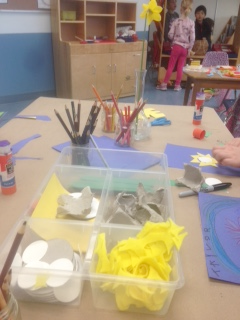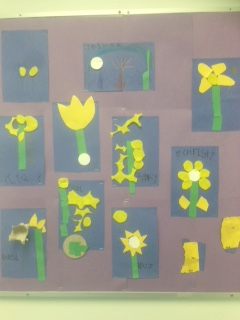4 Hour Class - Playground Detectives 2: WORMS!
March 28, 2016, 11:07 PM
In order to bring this discovery into the classroom the teachers brought in bins of soil to play with.
After some digging around we found some real, live worms in the bins!
That was when the questions began.
What do worms eat? How do worms see? Can a worm live when it has been cut in half?
We took a book out of the library to find some answers.
Here are some of the things that we learned about worms:
- they don't have eyes
- they can grow a new head or tail, but will not survive being cut in half
- they eat leaves, grass, dead trees (and roots), and food scraps
- they do not like the sun and will die if they are exposed for more than an hour or two
- their poop is ok to touch
- there are no "girl" worms or "boy" worms - all worms are both!
- the reason that worms squirm around in your hand is because they like all parts of their bodies to be touched at the same time.
We also did some worm-inspired art!
 |
| Worms in dirt |
 |
| Worms digging tunnels |
Then we did a worm search!
This involved guessing where we might find worms that had come out of the wet ground and onto the pavement or playground floor. So we made a list of some of the playgrounds we know and guessed if we would be able to find worms there. Here are the results:
We chose 3 parks: West, Climbing Spider, and Mushroom and headed out to see if we were right!
Much to our surprise, we discovered that the only park that had worms was our own!
 |
| Except for one dead worm that we found at Climbing Spider Park |
Here are the results of our search:
One of the other preschool classes heard about our adventures and asked if we would come and share with them. We gladly accepted the invitation and brought our bins of dirt and our newly aquired knowledge and joined them at circle time one day. We told them the facts that we learned and invited them to dig in the bins with us.
Then we all went out to the playground and released the worms outside.
At the playground we made an interesting discovery
 |
| We crowded around to take a look at... |
 |
| ...REAL LIVE WORM POOP!!! |
Keep your eyes open you just might see some worms (or worm poop) too!
Comments
Inspirational Art
March 14, 2016, 12:30 PM
In
our classroom we are always looking at how to incorporate the outdoors into the
classroom. One of the ways we have been doing that is by bringing in the
planter boxes from the deck and discovering what happen to the bulbs we had
planted back in the fall.
We
showed the children the bulbs they had help planted back in the Fall to remind
them what they looked like.
We then showed the children the planter box, most of the children were amazed at how the flowers had grown from a bulb. How did the petals fit inside the blub? How did the flower get to be yellow?
We
thought to further our observation of the planters box we would put some
material that would inspire the children to create their own art with the
planter box inside the classroom.
We
admire the uniqueness that inspirational art brings to the classroom as seen in
the picture above. Some children were inspired to make the daffodils whilst
others prefer to do one or two petals of a flower, or maybe it could be a
daffodil.
The following week I was “inspired” after seeing how much creativity the planter box bought into the classroom, on one of my many “runs”, I came across this fallen branch that I thought the children could again discuss and enjoy at the art table.
Inspirational
Art brings uniqueness and creativity in children. We don’t always see what the
child sees, allowing inspiration in the classroom demonstrates his or her
creativeness and interest that can reflect on how each child learns about the
world around them.
Until
next post
Jess
Investigation File: Aliens and Outer Space
March 10, 2016, 10:06 AMIt all happened one day when two of our children found some mysterious bowls in the play kitchen area. They tested the bowls by placing them on their faces. Suddenly, they were aliens!
Other friends joined in the conversation
and fun, wondering about aliens, space, and beyond. As the week went by, we had
some inventive alien looks in the class using things they found in the
classroom. We then imagined and explored what outer space might look like and
how people might travel through space.

Bringing in books and pictures about
planets and galaxies, we noticed there are many planets, but each very
different. By understanding the distance of the planets from the sun, we
learned that some planets are hot (as they are closer to the sun) and some
planets are cold (as they are further away from the sun). We wondered what
other planets look like - is there land, water, food, and toys?
Jupiter is a real planet
Aliens in space! Aliens are far away and they live in spaceships
We can have robots in space. There is water!
Mommy and daddy want to go to space
Some planets are hot. They are red.
Everyone got excited when the conversation
turned to aliens. The children had the following questions regarding aliens:
What
do their eyes look like?
What do their noses look like?
What do their eyebrows look like?
Do they eat moon rocks?
Do they eat carrots?
We then talked about earth, where we live,
and the reason we live on earth. The children observed that a globe has some
green and a lot of blue. They also noticed that the globe spins. We talked
about how earth is just right for humans.
The children were very engaged when
learning about earth, planets, space, and beyond. We will continue our
investigation for reporting.
Pretend space station play
Playing with space sand
Art with shaving cream and
paint
Tin foil art of planets
and aliens
Signing off,
Karen & Michelle
Tent Day in Preschool
February 29, 2016, 12:16 PM
The Three and Four-Year-Old
Class spent a morning recently under the tables, as sheets transformed the
tables into quiet, attractive hide-away. Table-top toys, became under-table
toys.
Waiting for the children
to arrive:
The children entered the
room very quietly and seemingly in awe of how their classroom had been
transformed.
It took a few moments for
the children to take in the new arrangement. They soon crawled under a table of
choice and from that point onward spent time visiting each makeshift tent with
excitement and anticipation of what was mysteriously awaiting them. The
children took turns and adjusted their play to make room for more friends.
Some children spent a very long while under one specific tent, while others
hurriedly went from one tent to another.
A colourful table cloth was
placed on the floor for snack-time. This small change of routine turned out to
be very enticing to the preschoolers. Everyone loves a picnic!
After morning tidy-up,
reading time took place under the tents as well.
Warm lighting in the
A-frame tent made for a cozy reading area:
A fun morning was had by the
children in both classes. It was very enjoyable for us, the teachers, to
witness the children's excitement and pleasure.
We look forward to having
another tent day in the future. A fun extension may be to have the children set
up the tents on their own this time.
Barbi
A Puddle!
February 15, 2016, 03:22 PM
On a recent outdoor day I was completely surprised by Hans curiosity
when he discovered a puddle. During the 30 minutes we were outside Hans continued
to play by the puddle. When he jumped into the puddle, was it the ripples in the water that attracted him or
was it the sound of the water splashing?
At times Hans was planning on making the
puddle go away by kicking the water out of the puddle.
I find this to be interesting because inside the classroom Hans does
not like getting his hands wet or messy yet here we are outdoor and he is not
bothered about getting his hands and maybe his feet wet.
Playing in puddles is a great sensory learning and physical experience
for children to learn concepts of floating, sinking, and measuring depth and width. And
not to forget the physical workout children receive form playing in something
as simple as a puddle!
Hans dropping a stone into the water, watching the ripples the water is
making
Hans dropping a stone into the water, watching the ripples the water is
making
Another friend runs into the puddle while Hans watches. Is he watching
to copy his classmate or is he wondering where will the puddle go?
Back in the classroom we walk on a large piece of brown
paper to see our footprints.
Until the next post.






























































